Why does my cat have dilated pupils?
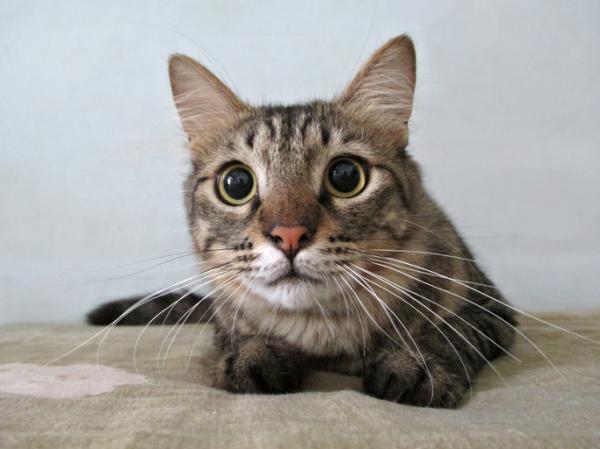
In addition to body language, cats use their eyes to communicate with us, other cats and animals of different species. For many, the look of a cat is one of the most mysterious due to the shape so characteristic of their pupils, but what happens when they are completely round? In general, pupils of cats tend to resemble a vertical line, not a circle, so it is not surprising that when witnessing this change the tutors are alarmed. In this article we will talk about this and explain why your cat has very dilated pupils, keep reading!
Meaning of the pupils of cats
Over the years the domestic cat has been evolving and adapting some of its natural habits, and an example of this is its hunting preference. Due to the dangers that lurked, the ancestors of the current cats were nocturnal animals that took advantage of the darkness of the night to feed themselves and, at the same time, protect themselves from possible predators. This was possible thanks to the anatomy of his eyes, which provides this animal with excellent night vision. For this, the feline dilates the pupil as much as possible in order to favor the entry of the greatest amount of light. In addition, in the eyes there is a tissue called tapetum lucidum that, in a summarized way, allows absorbing and retaining the light before reaching the retina, a fact that guarantees a much sharper vision at night.
During the day, the cat contracts the pupil and keeps it more or less closed depending on the amount of light that there is. Thus, in general, we find the pupils of cats with three different forms:
- Vertical pupil. It is contracted to avoid an excessive entry of light, since otherwise the animal would be completely dazzled.
- Elliptical pupil. It is partially dilated.
- Round pupil. It happens when the pupil of the cat is totally dilated, mainly, in spaces or schedules of low light.
However, the entry or not of the light is not the only reason that leads the cat to contract or dilate their pupils, since in many cases it does so as a reflex that shows their mood or health. Below we expose these causes.
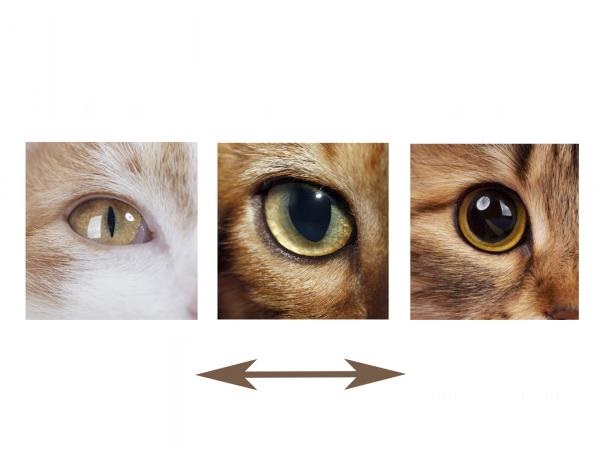
Why does my cat have round pupils?
Once explained the function of the pupils in terms of the entry of light, something totally natural and typical of most animals, it is important to note that the dilation of the pupils can also be due to other factors. Thus, the answers to why your cat has dilated pupils are numerous and may be related to situations or reactions to health problems. Focusing on those causes related to emotions and feelings, round pupils in cats express:
- Excitement: when the animal is very excited and nervous, for example, during a game session, it is usual to see it with round or elliptical pupils. However, excitement does not always occur because of positive stimuli, since it can also occur through stress or anxiety.
- SatisfactionIn situations that produce happiness, the cat also dilates its pupils as a reflex. An example may be when we fill your food bowl.
- Fear: the cat has dilated pupils and eyes wide open. This is a clear sign of fear and fear, which can be caused by a change, a loud noise, a situation, etc.
- Aggressiveness: the cats dilate their pupils when they stare at their prey and prepare to attack, so if you observe yours in a similar attitude, you feel threatened and think about defending yourself.
Although some of the causes that explain why a cat has round pupils are positive, it is important to note that this it is not the usual way. In any case the dilation indicates that the animal is not relaxed, and if it happens because he is playing or practicing some good activity for him, we should not worry, but if a large part of the day we observe his dilated pupils we should start thinking that the state of our cat is not adequate. It is possible that the animal is stressed by something, does not feel comfortable or safe, and it is our duty to find the reason that is disturbing it to treat it and restore emotional stability. For this, we recommend visiting the article “Things that stress the cats.”
On the other hand, it is important to emphasize that each cat is a world and can develop their own forms of communication, so that not always the dilated pupils are reason for warning. With this we do not mean that we should not give the importance it deserves, but it is fundamental to know our feline, his character, behavior and reactions to learn to identify a warning sign. Likewise, there are breeds of cats with a predisposition to show elliptical or dilated pupils without this posing an underlying problem, such as the British Shorthair cat.
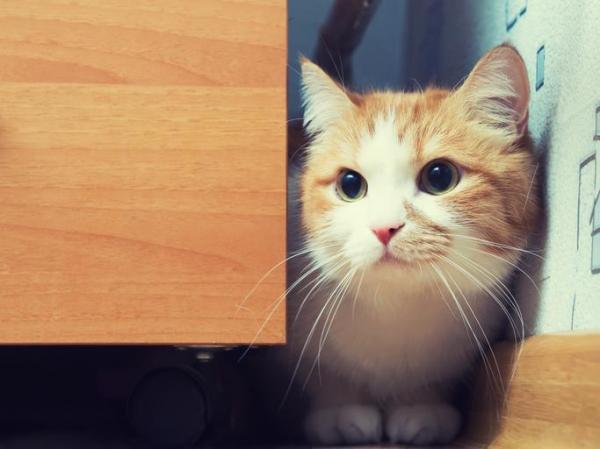
Cat with pupils dilated due to health problems
There are certain pathologies and conditions that show the dilatation of the pupils in their symptoms, so if the light in the environment is normal, there are no stressors or stimulants but, even so, the cat has round pupils, it is time to think about their state of health, especially if they are elderly. The most common conditions and diseases presented by Dilation of the pupils as a symptom They are:
- Glaucoma
- Uveitis
- Renal
- Hypoglycemia
- Feline leukemia virus (FelV)
- Some types of cancer
- Poisoning
- Head trauma
- Eye discomfort or injury
- Anisocoria
In the following sections we will highlight some of these problems, which also help us understand why a cat has dilated pupils and does not move.
Anisocoria in cats: one pupil larger than the other
Anisocoria in cats is the condition for which the animal presents the unequal pupils, so that one of them is more or less dilated than the other. This problem not only affects cats, since it can also occur in other animals, including humans. In certain situations this difference may be habitual, however, when the condition becomes permanent, it is not normal and we must act.
To know if the cat suffers from this problem, we will look at the most common signs. In addition to the obvious asymmetry of the pupils, another symptom of anisocoria in cats has to do with obvious eye discomfort, so it is common to see the affected animal scratch your eyes often and in different ways. Likewise, in the majority of cases, another sign present in anisocoria is the bluish coloration of the eyes, which shows them opaque and / or reddened. It is also possible to observe the presence of legañas or abundant secretions, which do not allow to open the eye normally. All of these symptoms can impair the animal’s vision, so it is likely that it will collide with objects or furniture, that it will walk weird or disoriented. Apathy and decay usually appear as a result of general malaise.
La Anisocoria is a symptom It can develop as a result of other diseases or eye problems, such as feline leukemia, corneal ulcers or uveitis. Therefore, if your cat has dilated pupils asymmetrically, you should go to the veterinarian to find the underlying cause, since the treatment will depend on it.
Dilated pupils in cats due to glaucoma and other ocular pathologies
El glaucoma in cats it is a disease that involves increasing the pressure of the fluid inside the eye (aqueous humor). In the eyes of the cats, and in ours, there are drainage channels that, if blocked, cause the aqueous humor to accumulate and, therefore, the intraocular pressure to increase, causing glaucoma and other problems derived from it, such as blindness.
However, glaucoma is not an ocular condition that can cause dilation in the pupils of cats. Likewise, this pathology can also appear as a consequence of another, so it is essential to review all the eye problems which may have as a symptom round pupils:
- Retinal detachment
- Uveitis
- Progressive retinal atrophy
- Disorders of the optic nerve
- Corneal injury
- Ocular tumor
- Cataract
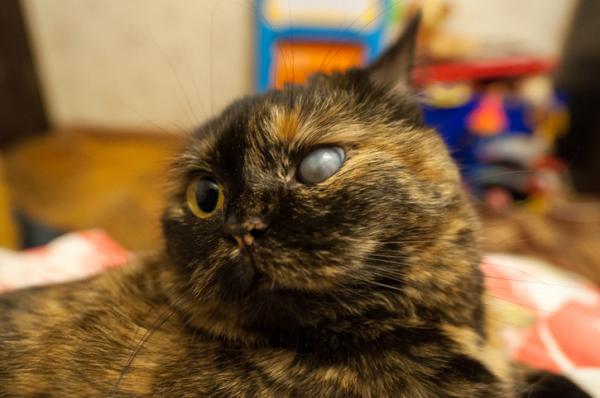
Cats with pupils dilated due to kidney failure
As in the cases of glaucoma or anisocoria, the elderly cats They are the most likely to suffer from kidney failure. However, it is also possible to observe this pathology in younger cats, so we should not rule it out if the symptoms coincide. Although it can be strange to relate the renal failure with the dilation of the pupils, the truth is that there is a good justification for it. When a cat suffers renal insufficiency it also suffers from hypertension which, in turn, causes some eye problems such as hemorrhage, retinal detachment, blindness, etc. For this reason, the cat can dilate their pupils and turn this sign into another symptom of the disease.
In addition to eye problems and pupillary dilation, symptoms of kidney failure in cats that can alert them to their presence are the following:
- Apathy
- Loss of appetite
- Weight loss
- Polydipsia and polyuria (drinking and urinating a lot)
- Vomiting
- Diarrhea
- Excessive hair loss
- Dehydration
- Pale mucous
Si your cat has dilated pupils and does not move, it is possible that this is the cause. Renal failure should be treated immediately since it is a serious pathology that can end the life of the animal. For more information, check out our article “Kidney failure in cats – Symptoms and treatment” and consult with your veterinarian, especially if your pussycat has more than 7-8 years and has one or more of the symptoms mentioned.
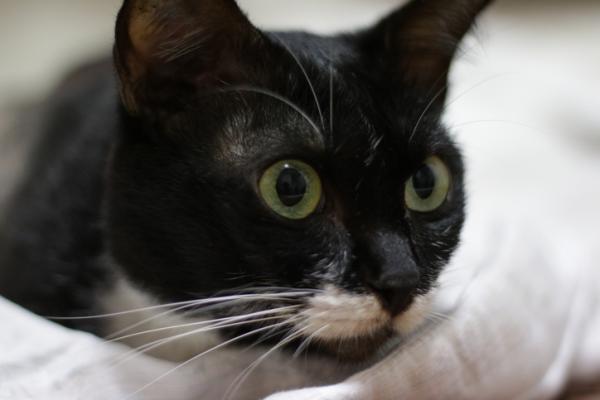
Tips for cleaning a cat’s eyes
Although we have seen that the causes that explain why a cat has dilated pupils are many and do not necessarily imply a lack of cleanliness, it is always recommended maintain good hygiene of this part of the body to avoid irritations or problems caused by dirt. Here are some tips:
- If the cat produces a lot of legumes, they should be removed every morning with a sterile gauze and physiological saline or chamomile failing.
- It is good to fix a cleaning routine from the most delicate areas, such as eyes and ears, from puppies. For adopted cats, this point is also important, always little by little and through positive reinforcement.
- If the hair around the eyes is too long, it should be trimmed to prevent it from penetrating the eyes and causing injury.
- If the cat presents ocular discharge, inflammation, redness or excessive itching, it should be taken as soon as possible to the veterinarian.
In our article “How to clean the eyes of a cat?” We detail all the necessary material for its hygiene, steps to follow and recommendations.
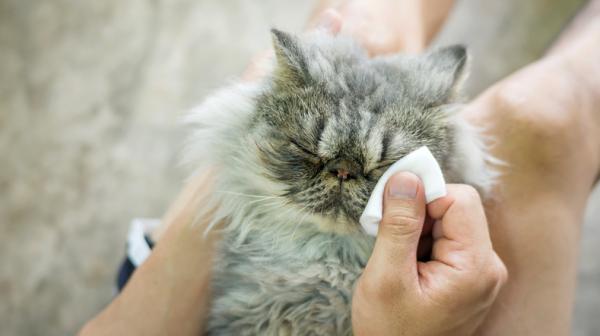
This article is merely informative, in .com we do not have the faculty to prescribe veterinary treatments or make any kind of diagnosis. We invite you to take your pet to the veterinarian in case of any type of condition or discomfort.
If you want to read more articles similar to Why does my cat have dilated pupils?, we recommend that you enter in our section of Eye Problems.


